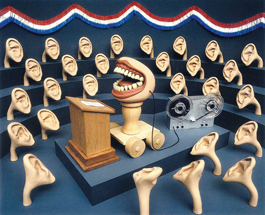home | metro santa cruz index | the arts | visual arts | review

Jim Haberman, 'The Speech'
All Ears : Jim Haberman's 'The Speech' takes its place in a juried show of 70 works at the Santa Cruz Art League.
Art with Homework
The Santa Cruz Art League's challenging new show has staying power
By Maureen Davidson
There's no skimming through "Visual Politics: Art & the American Experience," the exhibition of political art that just opened at the Santa Cruz Art League. The 70 works by artists from all over the country require a few hours of deep consideration in the quiet of the Art League galleries--but after that, there's homework. Communicated through powerful images, ideas have a long half-life in dreams and in the unconscious. These artworks don't just express ideas. They ponder them.
The venerable Art League shot for the moon by inviting Aptos artist, curator and activist Lucien Kubo to organize a national political exhibition. She approached the esteemed Peter Selz to serve as juror. An internationally respected art scholar, curator, educator and writer, Selz was the first curator of contemporary painting at the New York Museum of Modern Art in the 1950s and, more recently, founder and director of the Berkeley Art Museum. He agreed, and 129 artists from around the country submitted 278 works to him to be considered for the show's 70 places.
Some are well-known, like Ursula O'Farrell, who lives locally but shows internationally. Flying (Into It) is a large oil on two panels. The paint is laid on in thick, bold expressionistic strokes to create a vast dramatic scape full of turmoil--figures in the foreground are alight in a cool pink glare. An adult with arm around a child holds the red string of a kite, which leads into the distance, where massive structures loom out of a smoky haze; there is a burst of white. The scene is emotionally charged, lit by sudden cataclysm. Ordinary people bear witness to a moment in history. The image lingers.
Wax- and sand-encrusted objects tumble down matted strands of twine toward bronze puddles below in an untitled installation by Alexandra Ostroff. The globby curtain serves as both the vehicle for descent and a spidery filament that traps and suspends these beautiful, gruesome objects--bronze penises and gaping waxy tubes, like a makeshift display of human reproduction or horrifying trophies from a warlike culture.
Mary Snowdon borrows a lively illustrative style from children's books or comics to create characters, then sets them within a more dimensional environment in large-scale works on paper. In the chaos of Katrina, a cheerful, nattily dressed pig wields the oars of a sturdy rowboat through a waterlogged neighborhood. In the murky slop two men ride an almost-sinking metal tub, and a hand emerges imploringly from the deep. It's a chaotic meld of fantasy and realism.
The 70 works in this exhibition range from the grotesque (linocuts by Marcus Howell peopled with sinister self-occupied ne'er-do-wells) to the classical (Terry Kreiter's gorgeous Machine Gun, Telescope and Drum of Oil, a quiet reflection of the beauty of functional things, united by ill intent) to the contemplative (Bill Clark's haunting remake of the American flag, each stripe a serene panoramic photograph of white marble gravestones stretching to the horizon. At the bottom: "Acreage now available for additional 1.9 million gravesites in national cemeteries," a quote from the U.S. Department of Veteran Affairs).
The content of "Visual Politics: Art & the American Experience" ranges from oil greed to Katrina disaster, from diatribe against the Bush administration to an ironic reminder of Clinton and Monica. There's anger at brutality and horror at torture and a unifying sense of loss of innocence or perhaps of national morality. Whether fist-waving or thoughtful, these are powerful works of art.
Perhaps most memorable of all are three triptychs by James Groleau. Using an excruciatingly difficult intaglio technique, Groleau has honed the expression of human emotions to the barest minimum in bandaged and hooded portraits revealing perhaps only eyes brimming with tears or leveled with anger, or mouths agape in anguish--heavy features barely emerging from shadow and pain. In these extraordinary images Groleau reaches beyond race, gender or nationality to a quintessential humanity.
VISUAL POLITICS: ART & THE AMERICAN EXPERIENCE continues through Nov. 23 at the Santa Cruz Art League, 526 Broadway, Santa Cruz. (831.426.5787 or www.scal.org
Send a letter to the editor about this story.
|
|
|
|
|
|